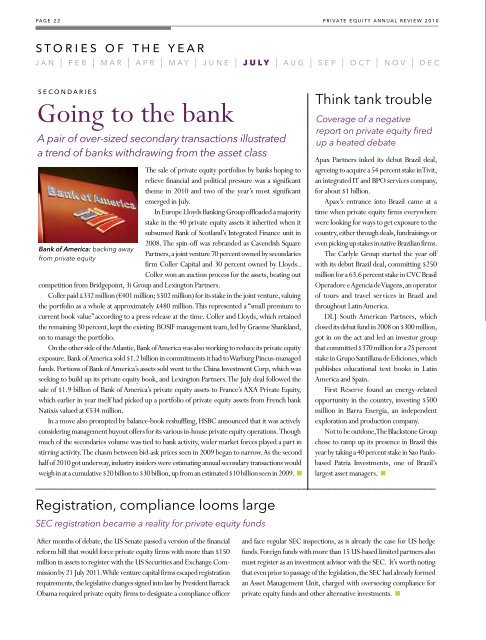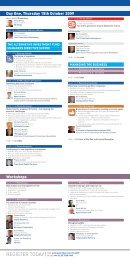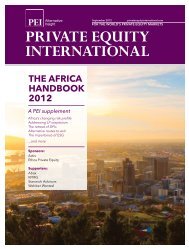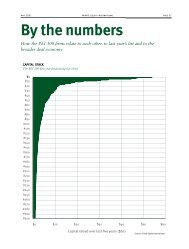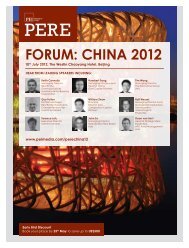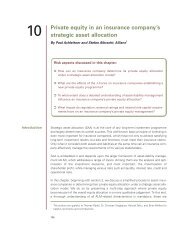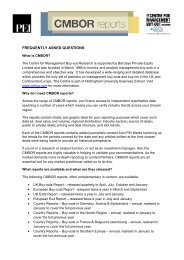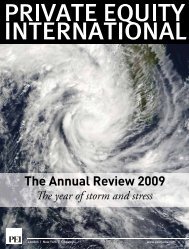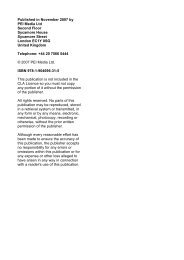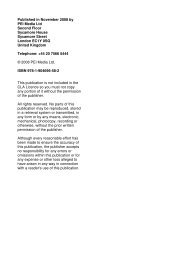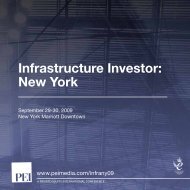THE ANNUAL REVIEW 2010 - PEI Media
THE ANNUAL REVIEW 2010 - PEI Media
THE ANNUAL REVIEW 2010 - PEI Media
You also want an ePaper? Increase the reach of your titles
YUMPU automatically turns print PDFs into web optimized ePapers that Google loves.
page 22 private equity annual review <strong>2010</strong><br />
s to r i e s o f t h e y e a r<br />
j a n | f e b | m a r | a p r | m a y | j u n e | j u ly | a u g | s e p | o c t | n o v | d e c<br />
s e c o n d a r i e s<br />
Going to the bank<br />
A pair of over-sized secondary transactions illustrated<br />
a trend of banks withdrawing from the asset class<br />
Bank of America: backing away<br />
from private equity<br />
The sale of private equity portfolios by banks hoping to<br />
relieve financial and political pressure was a significant<br />
theme in <strong>2010</strong> and two of the year’s most significant<br />
emerged in July.<br />
In Europe Lloyds Banking Group offloaded a majority<br />
stake in the 40 private equity assets it inherited when it<br />
subsumed Bank of Scotland’s Integrated Finance unit in<br />
2008. The spin-off was rebranded as Cavendish Square<br />
Partners, a joint venture 70 percent owned by secondaries<br />
firm Coller Capital and 30 percent owned by Lloyds..<br />
Coller won an auction process for the assets, beating out<br />
competition from Bridgepoint, 3i Group and Lexington Partners.<br />
Coller paid £332 million (€401 million; $502 million) for its stake in the joint venture, valuing<br />
the portfolio as a whole at approximately £480 million. This represented a “small premium to<br />
current book value” according to a press release at the time. Coller and Lloyds, which retained<br />
the remaining 30 percent, kept the existing BOSIF management team, led by Graeme Shankland,<br />
on to manage the portfolio.<br />
On the other side of the Atlantic, Bank of America was also working to reduce its private equity<br />
exposure. Bank of America sold $1.2 billion in commitments it had to Warburg Pincus-managed<br />
funds. Portions of Bank of America’s assets sold went to the China Investment Corp, which was<br />
seeking to build up its private equity book, and Lexington Partners. The July deal followed the<br />
sale of $1.9 billion of Bank of America’s private equity assets to France’s AXA Private Equity,<br />
which earlier in year itself had picked up a portfolio of private equity assets from French bank<br />
Natixis valued at €534 million.<br />
In a move also prompted by balance-book reshuffling, HSBC announced that it was actively<br />
considering management buyout offers for its various in-house private equity operations. Though<br />
much of the secondaries volume was tied to bank activity, wider market forces played a part in<br />
stirring activity. The chasm between bid-ask prices seen in 2009 began to narrow. As the second<br />
half of <strong>2010</strong> got underway, industry insiders were estimating annual secondary transactions would<br />
weigh in at a cumulative $20 billion to $30 billion, up from an estimated $10 billion seen in 2009. ■<br />
Think tank trouble<br />
Coverage of a negative<br />
report on private equity fired<br />
up a heated debate<br />
Apax Partners inked its debut Brazil deal,<br />
agreeing to acquire a 54 percent stake in Tivit,<br />
an integrated IT and BPO services company,<br />
for about $1 billion.<br />
Apax’s entrance into Brazil came at a<br />
time when private equity firms everywhere<br />
were looking for ways to get exposure to the<br />
country, either through deals, fundraisings or<br />
even picking up stakes in native Brazilian firms.<br />
The Carlyle Group started the year off<br />
with its debut Brazil deal, committing $250<br />
million for a 63.6 percent stake in CVC Brasil<br />
Operadore e Agencia de Viagens, an operator<br />
of tours and travel services in Brazil and<br />
throughout Latin America.<br />
DLJ South American Partners, which<br />
closed its debut fund in 2008 on $300 million,<br />
got in on the act and led an investor group<br />
that committed $370 million for a 25 percent<br />
stake in Grupo Santillana de Ediciones, which<br />
publishes educational text books in Latin<br />
America and Spain.<br />
First Reserve found an energy-related<br />
opportunity in the country, investing $500<br />
million in Barra Energia, an independent<br />
exploration and production company.<br />
Not to be outdone, The Blackstone Group<br />
chose to ramp up its presence in Brazil this<br />
year by taking a 40 percent stake in Sao Paulobased<br />
Patria Investments, one of Brazil’s<br />
largest asset managers. ■<br />
Registration, compliance looms large<br />
SEC registration became a reality for private equity funds<br />
After months of debate, the US Senate passed a version of the financial<br />
reform bill that would force private equity firms with more than $150<br />
million in assets to register with the US Securities and Exchange Commission<br />
by 21 July 2011. While venture capital firms escaped registration<br />
requirements, the legislative changes signed into law by President Barrack<br />
Obama required private equity firms to designate a compliance officer<br />
and face regular SEC inspections, as is already the case for US hedge<br />
funds. Foreign funds with more than 15 US-based limited partners also<br />
must register as an investment advisor with the SEC. It’s worth noting<br />
that even prior to passage of the legislation, the SEC had already formed<br />
an Asset Management Unit, charged with overseeing compliance for<br />
private equity funds and other alternative investments. ■


